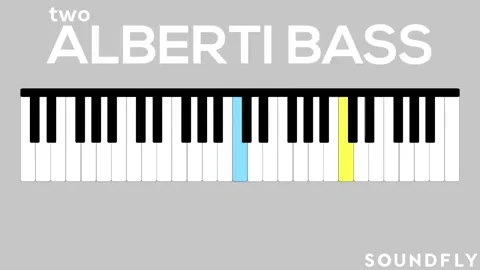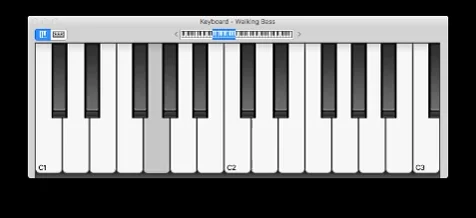Mickey Hansen
AP Music Theory 🎶
72 resourcesSee Units
How do we actually create musical textures? There are several strategies that composers like to use.
Texture in the Bass Line
The first textural device we can use appears in the bass line. There are two common bass lines: Alberti bass and walking bass.
Alberti bass consists of a repeating arpeggio pattern that moves in a continuous, rolling motion. It is typically played on a keyboard instrument, such as a piano or harpsichord, and is used to provide a sustained and harmonically rich accompaniment to a melody. The pattern is usually played in the left hand while the right hand plays the melody.
The standard Alberti bass pattern consists of a broken chord in which the notes are played in a descending order, starting with the root of the chord, then the fifth, then the third, and finally the root again. The pattern then repeats, starting on the next chord in the progression. This creates a smooth, flowing accompaniment that can provide a sense of forward momentum and momentum to a piece of music.
Here’s what an Alberti bass might look like

Alberti bass is usually used in piano or keyboard music, and it was used very often in the classical era: Mozart, Beethoven, and Haydn used Alberti bass often. A very famous piece that uses Alberti bass is Mozart’s Sonata No 16 in C Major. Can you hear the Alberti bass?
Walking bass is a type of bass line that is commonly used in jazz, blues, and other forms of popular music. It is characterized by a continuous, forward-moving motion that creates a sense of momentum and drives the rhythm of the piece.
In a walking bass line, the bass player typically plays a series of quarter notes or eighth notes that move in a stepwise motion, either ascending or descending. The notes of the bass line are typically played on the beat and outline the chord progression of the piece. Walking bass lines are often played on a bass guitar or a double bass, and they can be played with a variety of techniques, including plucking, slapping, and bowing.
Here’s an example of a walking bass line:

Polyphonic Textural Device
Polyphony is a type of musical texture in which two or more independent melodic lines are combined to create a complex, harmonically rich sound. Polyphonic music is characterized by the interweaving of multiple melodic lines, each of which has its own rhythm, melody, and harmonic structure.
Polyphonic music can be created through a variety of techniques, including various contrapuntal techniques, in which multiple voices move against or with each other in a harmonically interdependent way. It can also be created through the use of harmony, in which multiple voices play different pitches at the same time to create chords.
There are two special forms of counterpoint that create unique textures: canonical music. imitation counterpoint, and countermelodies.
A canon is a type of musical composition in which a melody is imitated by one or more voices in a staggered or overlapping fashion. Canons are often characterized by their strict, formal structure and their use of repetition and imitation as compositional devices.
There are many different types of canons, and they can vary in terms of their length, number of voices, and degree of complexity. Some common types of canons include:
- Round: A round is a type of canon in which a melody is repeated by different voices at different times, creating a harmonically rich texture. The most famous example of a round is probably "Row, Row, Row Your Boat," in which the same melody is sung by different voices at different times.
- Fugue: A fugue is a type of canon in which a single melodic subject is repeated and imitated by multiple voices, each entering at a different time. Fugues are a common form in Baroque music and are often characterized by their complex, contrapuntal textures and strict, formal structure.
- Canon at the octave: A canon at the octave is a type of canon in which the voices imitate the melody at an interval of an octave (eight scale degrees) above or below the original melody. This creates a harmonically rich texture and can add depth and complexity to the music.
One well-known example of a canon in music is the Canon in D by Johann Pachelbel. This piece is a three-voice canon in which the voices enter in a strict, imitative fashion, with each voice beginning a few measures after the previous one. The melody is relatively simple and is based on a repeating four-measure phrase that is repeated throughout the piece. The voices enter in a consistent order, with the top voice entering first, followed by the middle voice, and finally the bottom voice. The piece is harmonically straightforward, with the voices moving in parallel motion and outlining a series of chords in the key of D major.
Imitation counterpoint is a type of counterpoint in which one voice imitates the melody of another voice, either exactly or with some variations. Imitation is a common technique in counterpoint and is used to create a sense of unity and coherence among the voices.
In imitation counterpoint, the imitating voice typically enters a short time after the original melody, creating a call-and-response effect. The imitating voice may repeat the melody exactly, or it may vary it slightly by changing the rhythm, the melody, or the intervals between the notes. The imitating voice may also introduce new melodic or rhythmic elements, as long as it remains harmonically consistent with the original melody.
One well-known example of imitation counterpoint is the Fugue in D minor from The Well-Tempered Clavier, Book 1 by J.S. Bach. This fugue is a three-voice piece in which the voices enter in a strict, imitative fashion, with each voice beginning a few measures after the previous one. The subject of the fugue, which is the main melodic idea that is repeated and imitated by the voices, is a four-measure phrase that is characterized by its use of chromaticism and its angular, dissonant intervals. The voices enter in a strict order, with the top voice entering first, followed by the middle voice, and finally the bottom voice. As the piece progresses, the voices engage in a complex interplay of imitation and variation, creating a harmonically rich and intricate texture.
Finally, a countermelody is a secondary melody that is played or sung at the same time as the main melody in a piece of music. It is typically played by a different voice or instrument and serves to add interest, variety, and harmonic complexity to the music.
One well-known example of a countermelody is the violin melody that accompanies the main piano melody in the first movement of Beethoven's "Moonlight Sonata." In this piece, the violin plays a flowing, lyrical melody that complements the more expressive and dramatic melody played by the piano. The two melodies interact and support each other, creating a harmonically rich and emotionally powerful musical texture.

Other Textural Devices
There are a few more textural devices you should know: a solo/soli and accompaniment, doubling, ostinato, and tutti
A solo is a musical performance by a single performer, while soli (the plural of "solo") refers to a section of a musical composition or performance in which a group of performers plays or sings together.

Here are examples of solos and soli:
- Solo: One well-known example of a solo is the violin solo in the first movement of Beethoven's Violin Concerto. In this piece, the violin plays a virtuosic and expressive melody that stands out against the accompaniment provided by the orchestra.
- Soli: An example of soli is the section in the overture to Mozart's The Marriage of Figaro in which the orchestra plays a fast and energetic melody in unison. This section is a soli in which all of the instruments in the orchestra play together, creating a bold and powerful sound.
A solo or soli might be played with an accompaniment, which is the “background music” to the solo. Usually, the accompaniment is relatively unobtrusive, allowing the solo to shine through.
Doubling in music refers to the practice of having multiple performers play or sing the same part in a piece of music. Doubling can be used to create a fuller, more harmonically rich sound, or it can be used to create a sense of balance or clarity within the ensemble.
Two voices might double each other exactly, or they might be an octave apart. In chamber music, this is often used to highlight the melody of the piece.

Next, an ostinato is a musical device in which a short melodic or rhythmic phrase is repeated over and over again. Ostinatos are often used to create a sense of energy and momentum in a piece of music and can help to drive the rhythm and pulse of the piece. They can also be used to create a sense of repetition and stability, and can help to establish a sense of musical form within a piece.
One example of an ostinato in classical music is the "toccata" motive in Bach's Toccata and Fugue in D Minor. This motive is a short, rhythmic pattern that is repeated throughout the piece and serves as the foundation for the rest of the music. The motive is played by the organ in a fast, virtuosic fashion and helps to create a sense of energy and excitement. The repetition of the motive creates a sense of stability and helps to establish the form of the piece.
While there is some overlap between ostinatos and motives, there are some key differences. Ostinatos are characterized by their repetition and stability, while motives can be varied and developed throughout a piece of music. Additionally, ostinatos often serve as a foundation or accompaniment for the rest of the music, while motives can be more structural and thematic in nature.
Finally, tutti is an Italian term that means "all" or "everyone." In music, it is typically used to refer to a passage or section in which all of the performers in an ensemble play or sing together. Tutti passages are often characterized by a full, rich, and harmonically complex sound, and they can be used to create a sense of power and impact within a piece of music.

🦜 Polly wants a progress tracker: If you are singing in a school choir, what are the various textures that you may encounter in your own vocal part?
Browse Study Guides By Unit
🎵Unit 1 – Music Fundamentals I (Pitch, Major Scales and Key Signatures, Rhythm, Meter, and Expressive Elements)
🎶Unit 2 – Music Fundamentals II (Minor Scales and Key Signatures, Melody, Timbre, and Texture)
🎻Unit 3 – Music Fundamentals III (Triads and Seventh Chords)
🎹Unit 4 – Harmony and Voice Leading I (Chord Function, Cadence, and Phrase)
🎸Unit 5: Harmony and Voice Leading II: Chord Progressions and Predominant Function
🎺Unit 6 – Harmony and Voice Leading III (Embellishments, Motives, and Melodic Devices)
🎤Unit 7 – Harmony and Voice Leading IV (Secondary Function)
🎷Unit 8 – Modes & Form
🧐Exam Skills
📚Study Tools

Fiveable
Resources
© 2025 Fiveable Inc. All rights reserved.